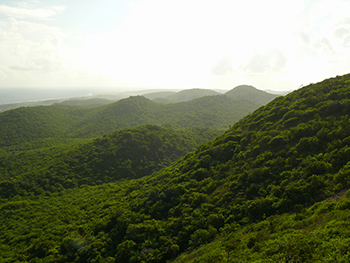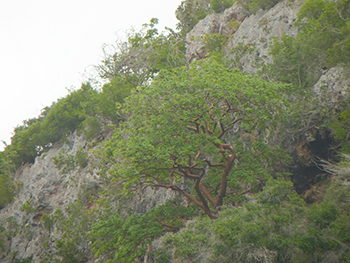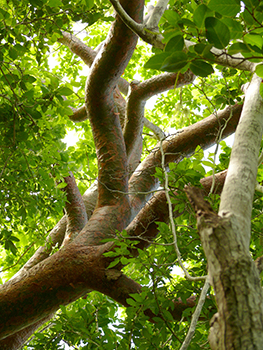This post is also available in: Dutch (below)
This series of articles was written and published in 2011 in the Antilliaans Dagblad newspaper. 2011 was the year that the United Nations declared the International Year of Forests, in order to give more attention to the “lungs” of the earth. Without forests, life on earth is impossible. The original series concerned the mondi of Curaçao and has been adapted and rewritten where necessary to also include the sister islands of Aruba and Bonaire. This first part will be published on International Forest Day in 2025, March 21.
What is a forest?
The word forest evokes different feelings in people. For many, a forest means a large untouched piece of land with a large collection of trees, for others a small piece of green is already a forest. The definition of a forest is nothing more than an area with trees; whether they are conifers or leafy trees, large or small, thick or thin.
Forests on Aruba, Bonaire and Curaçao

The ABC-islands also have forests, although they are somewhat different from the forests we have in mind when we think of the large areas of forests in, for example, Germany, the United States and the Amazon region in South America. The forests of the three islands, Aruba, Bonaire and Curaçao, are characterized by relatively low vegetation and a shrubby appearance. Really large trees are only found to a limited extent in the local nature.
The local forest of the islands is often seen as worthless, with reference to the thorny trees that occur there. However, that is a gross mistake, the typical Aruban, Bonairean and Curaçaoan mondi, filled with brasias and indjus, watapanas and kadushis and so much more, is the actual forest, the “forest” of the islands. The largest part of the biodiversity on the islands is found here. In addition to the mangrove forests of course.
Gradations in the forest on the ABC islands

The typical forest of Aruba, Bonaire and Curaçao also has gradations in development. In biology, the terms secondary and primary forest are used to indicate the development and the associated biological variation within a piece of vegetation. Primary forests are original forests with a large biological variation (biodiversity), a large number of different species of plants, animals and other organisms. Secondary forests are forests that have (recently) grown back after the original forest has disappeared due to destruction. This can be destruction as a result of forest fires, earthquakes or other natural disasters, but also as a result of the original vegetation being flattened by humans. Secondary forests generally have a low biodiversity, the number of different species of plants, animals and other organisms is considerably lower than in a primary forest. Some organisms never return.
People often make the mistake of thinking that a piece of land that has been bulldozed, has been fallow for a while and has turned into a green sea again after a few rain showers, has become mondi again, so that the original vegetation has grown back. Nothing could be further from the truth. The land may look green and fresh, but the secondary vegetation is considerably less diverse than what was there before. Where there used to be a varied forest, there is now a species-poor vegetation that on our island is usually characterised by large quantities of milkweed, grass and wabi.
The chance that a primary forest with the associated diversity will return to its original glory is quite small, but if it gets the chance, it will take tens if not hundreds of years to achieve this.
Did you know that:
- Forests are not only crucial for the water supply, biodiversity and providing for the needs of a large number of people, but that they are also closely linked to cultural development.
- 80% of terrestrial biodiversity occurs in forests?
- 25% of the world’s population depends on forests for survival

Bursera simaruba
The Palu di sia korá (Bursera simaruba) is a tree that is widespread from Florida, the entire Caribbean and Central and South America and also occurs on the three ABC islands. In the past, the tree was used on Curaçao to make so-called trankés, a living fence around a terrain. On Banda Abou you can still find several of these types of trankés. The tree is characteristic because of its reddish-brown bark that flakes.
Palu di sia korá (Bonaire and Curaçao) on Aruba called Palu di sia cora.

Bossen op de semi-aride ABC-eilanden (1) – Het bos dat ‘Mondi’ heet.
Deze artikelenserie werd in 2011 geschreven en gepubliceerd in het Antilliaans Dagblad. 2011 was het jaar dat door de Verenigde Naties werd uitgeroepen tot het internationaal jaar van de bossen, om zodoende de “longen” van de aarde meer aandacht te geven. Zonder bossen is leven op aarde namelijk onmogelijk. De oorspronkelijke serie betrof de mondi van Curaçao en is aangepast en waar nodig herschreven om ook de zustereilanden Aruba en Bonaire er ook in mee te nemen. Dit eerste deel wordt gepubliceerd op de International Forest Day in 2025, 21 maart.
Wat is een bos?
Het woord bos, forest in het Engels, wekt verschillende gevoelens op bij mensen. Voor velen betekent een bos een groot ongerepte stuk grond met een grote collectie bomen, voor anderen is een klein stukje groen al een bos. De definitie van een bos is niets anders dan een gebied met bomen; of dat nou naaldbomen of loofbomen zijn, groot of klein, dik of dun.
Bossen op Aruba, Bonaire en Curaçao

Ook de ABC-eilanden hebben bossen, al zijn die ietwat anders dan de bossen die we in gedachten hebben als we denken aan de grote oppervlakten met bossen in bijvoorbeeld Duitsland, de Verenigde Staten en het Amazonegebied in Zuid Amerika. De bossen van de drie eilanden, Aruba, Bonaire en Curaçao worden namelijk gekenmerkt door een relatief lage vegetatie en struikachtig aanzicht. Echt hele grote bomen komen in de lokale natuur maar beperkt voor.
Vaak wordt het lokale bos van de eilanden gezien als waardeloos, met referentie aan de stekelachtige bomen die er voorkomen. Dat is echter een grove vergissing, de typische Arubaanse, Bonairiaanse en Curaçaose mondi, gevuld met brasia’s en indju’s, watapana’s en kadushi’s en nog zo veel meer, is het daadwerkelijke bos, de “forest” van de eilanden. Het grootste deel van de biodiversiteit op de eilanden komt hierin voor. Naast de mangrovebossen natuurlijk.
Gradaties in het bos op de ABC-eilanden

Ook het typisch bos van Aruba, Bonaire en Curaçao kent gradaties in ontwikkeling. In de biologie worden de termen secundair en primair bos gebruikt om aan te geven wat de ontwikkeling en de daarmee gepaard gaande biologische variatie is binnen een stuk vegetatie. Primaire bossen zijn oorspronkelijke bossen met een grote biologische variatie (biodiversiteit), een grote hoeveelheid verschillende soorten planten, dieren en andere organismen. Secundaire bossen zijn bossen die (recent) zijn terug gegroeid nadat het oorspronkelijke bos is weggevallen door destructie. Dat kan destructie zijn als gevolg van bosbranden, aardbevingen of andere natuurrampen, maar ook als gevolg van het platwalsen van de originele vegetatie door de mens. Secundaire bossen hebben doorgaans een lage biodiversiteit, de hoeveelheid verschillende soorten planten, dieren en andere organismen is aanzienlijk lager dan in een primair bos. Sommige organismen komen er ook nooit meer terug.
Vaak wordt de gedachtenfout gemaakt dat een stuk grond dat is kaal gebulldozerd, een tijdje braak heeft gelegen en na wat regenbuien weer in een groene zee is veranderd weer mondi is geworden, dus dat de oorspronkelijke vegetatie weer is terug gegroeid. Niets is minder waar. De grond ziet er weliswaar groen en fris uit, maar de secundaire vegetatie is aanzienlijk minder divers dan wat er eerst stond. Waar eerst een gevarieerd bos stond, is er nu een soortenarme vegetatie wat op ons eiland doorgaans gekarakteriseerd wordt door in eerste instantie grote hoeveelheden Katuna di seda, gras en wabi.
De kans dat een primair bos met de bijbehorende diversiteit terugkomt in zijn oorspronkelijke glorie is vrij klein maar zal, mocht het de kans daartoe krijgen, tientallen zoal niet honderden jaren nodig hebben om dat te realiseren.
Wit je dat:
- Bossen niet alleen cruciaal zijn voor de watervoorziening, biodiversiteit en het voorzien in de levensbehoefte van een groot aantal mensen, maar dat ze ook nauwe verbonden zijn met culturele ontwikkeling.
- 80% van de terrestrische biodiversiteit in bossen voorkomt?
- 25% van de wereldbevolking afhankelijk is van bossen om te overleven

Bursera simaruba
De Palu di sia korá (Bursera simaruba) is een boom die wijdverspreid voorkomt vanaf Florida, het gehele Caribische gebied en Midden en Zuid Amerika en ook voorkomt op de drie ABC-eilanden. De boom werd in het verleden op Curaçao gebruikt om er zogenaamde trankés mee te maken, een levende afrastering van een terrein. Op Banda Abou vind je nog verschillende van dit soort trankés. De boom is karakteristiek door zijn roodbruine bast dat schilfert.
Palu di sia korá (Bonaire en Curaçao) op Aruba Palu di sia cora genoemd.